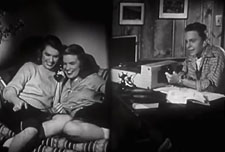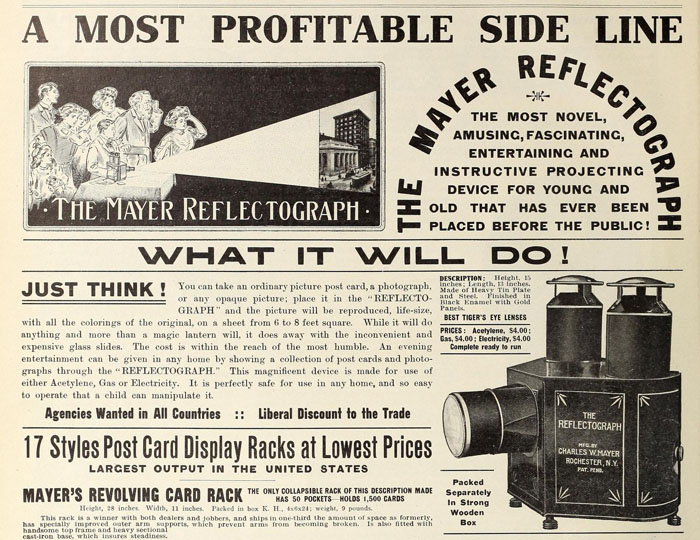PhonoMultimedia
 
Multimedia Using Images
and Recorded Sound
|
PhonoMultimedia are examples of
recorded sound that have been combined with different types
of images - magic lantern slides, postcards, book illustrations,
artwork, pictures captured on film, video tape, computers, etc.
There were also some devices which were combinations of a record
player and a projector.
The following are the categorized Gallery of PhonoMultimedia creations:
Magic
Lantern Shows have been created by using period phonograph
recordings to combine with period lantern slides as examples
of what could have been seen and heard by audiences
at the turn of the twentieth century.
Period
Magic Lantern Shows with period phonograph records are examples
of actual pre-1920 presentations which often were accompanied
by a narrator, lecturer, or other live entertainer.
Early
Moving Pictures, including some AI colorized film, can be
watched with added early phonograph recordings.
Talking
Books in this gallery
include all recorded books. This gallery has also created
some multimedia presentations using records which were not originally
a "talking book" (e.g., Cal Stewart records have been
combined with respective stories printed in Uncle Josh's
Punkin Centre Stories by Cal Stewart, Thompson & Thomas,
1905).
Other
PhonoMultimedia Presentations are created using art, postcards,
sheet music, phonograph attachments, and other ephemera which
are accompanied by a variety of recorded words and music.
PBS
Phonograph, Kinetoscope and related Videos by PBS, American
Experience, etc. are linked to respective previews and excerpts.
Movie
and Cartoon Clips with phonograph connections can be viewed
by visiting The Phonograph
in the Movies for list
of movies and cartoons.
Combination
Phonograph and Projector Devices - Designed for entertainment
(primarily for children), business, and education.
PhonoMultimedia Predictions seen in Popular Culture
Illustrations of Kinetoscopes and Picture Projecting Devices seen in Popular Culture
Miscellaneous
PhonoMultimedia - None of the above.
Select
a PhonoMultimedia presentation from below or use the PhonoMultimedia
Table of Contents.
|
In the early
1890's the Phonograph and the magic lantern provided multi-media
entertainment to paying audiences. The following have been
recreated using magic
lantern slides accompanied by cylinder phonograph records.
|
|

Adventures
of a Cyclist
accompanied by Ye Ancients March,
The Edison Concert Band, Record No. 8946
(1905)
|
|

Adventures
of Mr. Snapshot accompanied by American Students'
Walzes, Edison Record No. 8740 (1904)
|
|

America
accompanied by The Star Spangled Banner and
America, Indestructible Record No. 3943 (1908)
|
|

Annie's
Treat accompanied by an
1896 Regina music box playing The Nightingale Song.
|
| |
|
|
|
|
|
|
|

Are
Mr. and Mrs. Snapshot at Home?
accompanied by brown wax cylinder recording of Nanon
Waltz, circa 1891-1893.
|
|

Break
the News to Mother accompanied by J.W. Myers singing
Break the News to Mother, Columbia Records.
|
|

A
Christmas Carol
accompanied by �The Carol Singers� performing "God
rest you, merry gentlemen" on Edison Blue Amberol Record
No. 3346 (1917)
|
|
|
|
|
|
|
|
|
|
|

Killarney
accompanied by Miss Marie Narelle singing Killarney.
See Edison Record
No. 9081 for additional Narelle details.
|
|

Nursery
Rhymes illustrated by W. Butcher & Sons London
(ca. 1910) accompanied by Thousand-and-One Nights Waltz
played by the Edison Concert Band (1908)
|
|
|
|
|
|
|
|
|
|
|
|
Period
Magic Lantern Shows
The Phonograph
and magic lantern combined to provide multi-media entertainment
to many audiences from 1890 to 1920. The
following are some examples of those presentations.
|
|

The
Victrola at Wanamakers for 1910 Lenten Lecture on Wagner's
"Parsifal" using lantern slides and voices of opera
stars.
|
|
|
|
|
|
|
| |
|
|
|
|
|
|
|
|
|
|
|
|
|
|
Talking Books
The creation of some talking
books for this gallery (e.g., using Cal Stewart records and
pages from his book Uncle Josh's Punkin Centre Stories,
1905) illustrates how storytelling on records was not always
a word for word rendition (most often because of the medium,
i.e., the recording time limitation of cylinder and disc records).
The Talking Book Corporation, however, created early examples
of stories "narrated" word for word with the text
printed.
|
|

Uncle
Josh and the Lightning Rod Agent
- Uncle Josh's encounter with a Lightning Rod Agent from
his 1905 book Uncle Josh's Punkin Centre Stories by
Cal Stewart, "The Talking Machine Story Teller."
|
|

Uncle
Josh on a Bicycle
- Uncle Josh's rides a bicycle for the first time from
his 1905 book Uncle Josh's Punkin Centre Stories by
Cal Stewart, "The Talking Machine Story Teller." |
|
|
|

For examples of Talking Books
and Edison's 1878 prediction of phonograph books as one of
its 'probabilities' see Edison's The
Phonograph and Its Future: Phonographic Books.
|
| |
|
|
|
|
|
|
| PBS
Phonograph, Kinetoscope and Related Videos |
|

Edison:
From the Telephone and Telegraph
Comes the Phonograph - An American Experience video
Discover how
one invention led to another when Thomas Edison and his
Menlo Park laboratory team refined Alexander Graham Bell�s
telephone and, along the way, invented the phonograph,
a device, said the New York Times, destined to
"entirely eclipse" the telephone.(1)
|
|

The
Phonograph - An American Experience PBS video
On December 7, 1877
Thomas Edison demonstrated his phonograph at the New
York City offices of the nation�s leading technical
weekly publication, "Scientific American." This video
features that event and the fame it brought to Edison
(2:14 excerpted from the 2015 PBS American Experience
"Edison.")
"
|
|

The
Kinetoscope - An American Experience PBS video
In the 1890s, Thomas Edison
worked with his assistant and part-time photographer,
William Dickson to create a motion picture camera. They
created a series of short films that could be viewed on
a coin-operated, peephole viewing cabinet called a kinetoscope.
(3 minutes 32 seconds from 2015 PBS American Experience).
|
|

Fitness,
Flappers and Phonograph Records - PBS History Detectives
For the story of Wallace
Rogerson's exercise records being investigated as the
first of records of its kind host Tukufu Zuberi tells
the story to Wallace's granddaughter. (Aired on
9/5/2011 | 18m 3s.)
|
| |
|
|
|
|
|
|
|

Nipper Runs Amok!
(1900). Courtesy of EMI Archive Trust 1997. WATCH
the 700 photographs "Mutoscope" film.
|
|
|
|
|
|
|
Miscellaneous
PhonoMultimedia
PhonoMultimedia Predictions in Popular Culture

Prediction from 1900 of Opera in the Home in 2000 - Hildebrands Deuschter Chocolate Advertising Postcard Series of 1900 Predicting Future Home Entertainment in 2000, Number 4. This system used camera and telephone for live performance instead of phonograph.

Prediction from 1900 of Live Visual Correspondence in 2000 - Louit Chocolate Advertising Postcard of 1900 Predicting Correspondence Cinema-Phone-Telegraphique system in year 2000. This system used telephone for live communication, projection system and phonograph.

The Theater-o-Matic - Become part of any movie in a fully interactive scene. "The Brilliant Mind of Edison Lee," by John Hambrock, The Lincoln Journal Sunday Comics, February 2-23-2025. (Click comic strip to enlarge).
Illustrations
of Kinetoscope and Picture Projecting Devices

Edison Kinetoscope Parlor
1896, The Phonoscope
The Vitascope, The
Phonoscope, November
1896
"What the
Phonograph is to the ear, the Vitascope is to the eye. The camera
records the view, the Phonograph bottles up the sound, and
the Vitascope preserves the action for future use..."
- Our Correspondents,
The Phonoscope, November
1896

"There's Money in
a good Magic Lantern outfit," Munsey's Magazine,
advertising section, Vol.
16, p. 861, 1896.

The Phonoscope, April 1896

The Phonoscope, July 1897

The Phonoscope, October
1897
Munsey's Magazine,
April 1901 (quarter page ad, The Collection of Phonographia)
(PM-1827)

Suggestion for phonograph dealers
to sell a projecting device which uses post cards for illustrating
phonograph records. The
Talking Machine World,
February 1909.
As a business opportunity for phonograph
dealers to sell records the author of the TMW article asked the
following question:
How many times have you sat
in a theater where illustrated songs were rendered, and while
admiring the beautiful pictures thrown upon the curtain, longed
for some method of illustrating records without the large expense
involved in the purchase of a stereopticon and glass slides?
His answer was simple - Stock and
sell a post card illustrating device as part of your phonograph
business:
Records illustrated for a few
pennies! Think of the hit such an announcement will make with
your customers. Will they not be delighted, when they call upon
you to hear the new monthly supplements, to learn that they
can procure from you an outfit capable of producing beautiful
colored illustrations life-size on a screen, and when they hear
you name the price they will undoubtedly purchase it on sight.
The machine capable of doing
the illustrating is already before the public and can be purchased
at retail as low as $4, so no time need be taken up with a description
of it. It is simply necessary to state that it will do the work,
and do it well.

Watch Ring
Out the Bells for Christmas
- Edison Record No. 9806 released in 1907 and slide-show
using phonograph related postcards and illustrated ephemera.
("Christmas Wishes" postcard, PM-0225, December 23,
1910).

The Pal Picture Player, The Combination talkie-picture machine - "Playthings," April, 1930.
Additional
Information about the Snowball
Fight in Lyon, France 1897
This Lumiere brothers film has been upscaled, colorized
with AI added frames to enhance smoothness and facial
expressions. This Phonographia version has used
that version and accompanied it with Snow Queen
performed by the Indestructible Military Band
(1909)

The
Phonoscope, February 1898
The Phonoscope
for February 1898 in their section New Films
for "Screen Machines" announced that
"Macguire
& Baucus" was marketing "SNOW
BALLING." According to The
Thomas A. Edison Papers the Macguire & Baucus
"company entered the motion picture business
in 1894. During the period August-October 1894 it
acquired the exclusive rights to sell and exhibit
Edison's kinetoscopes and kinetoscope films in Europe,
Mexico and South America, the West Indies, Australia,
Burma, Ceylon, and India." "On December
7, 1897, Edison brought suit against the company
for infringement of his motion picture patents."
In that same edition
of The Phonoscope an article with pictures
featured the London office of Macquire & Baucus,
Ltd. noting they "have long been sole agents
for Great Britain, her colonies and the United States
for the Lumiere photographic films, perforated to
American (standard) gauge. As every well-informed
exhibitor knows, these Lumiere films are justly
celebrated."
See Wikipedia's Bataille de neige for additional details and a b-w version of the Lumiere No. 101 Snowballing film.
The
Cyclists' Elopement
- A Magic Lantern Presentation illustrated by Bamforth
& Co., (1897) accompanied by Peaceful Henry
played by The Edison Concert Band, Edison Gold Moulded
Record No. 8562 (1903).
A similiar 8-panel cartoon
titled "On the Wrong Tack - A Story of a Bicycle
Elopement and How it Succeeded" by F.
M. Howarth was in an 1894 Puck magazine.
Another 12-panel
elopement cartoon titled "A Blessing in Disguise -
The Story of a Successful Bicycle Elopement" by F.
M. Howarth was in an 1898 Puck magazine.

Valentine Postcard with Moving Picture theme (PM-2283)
|
































































